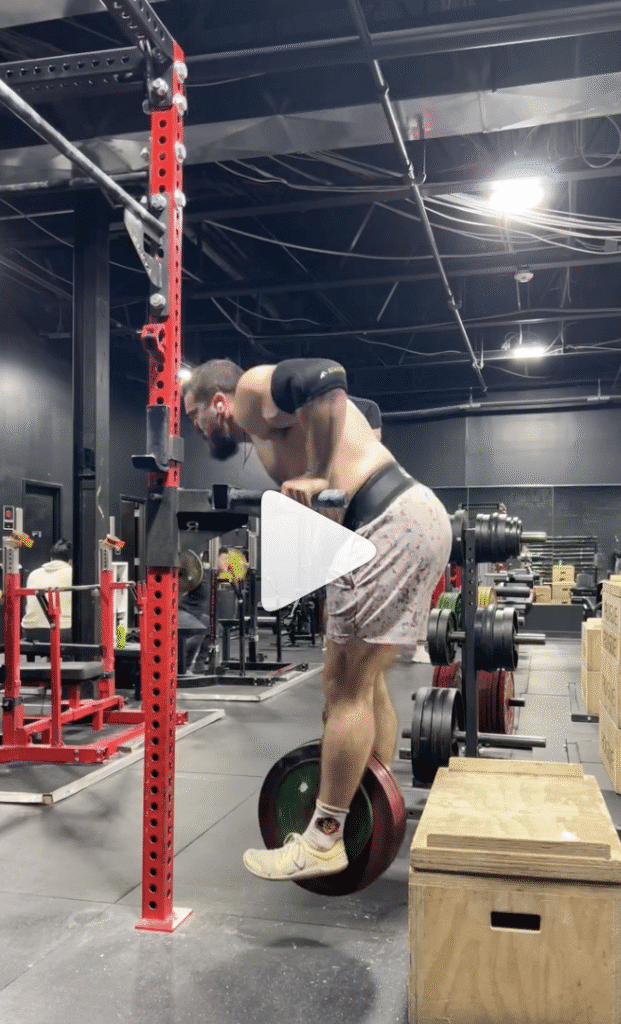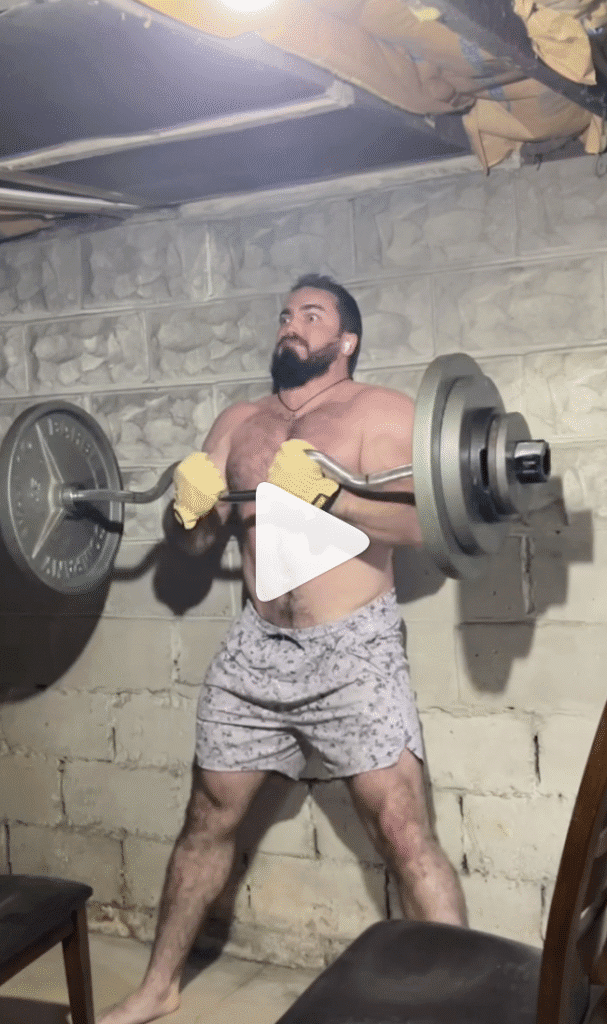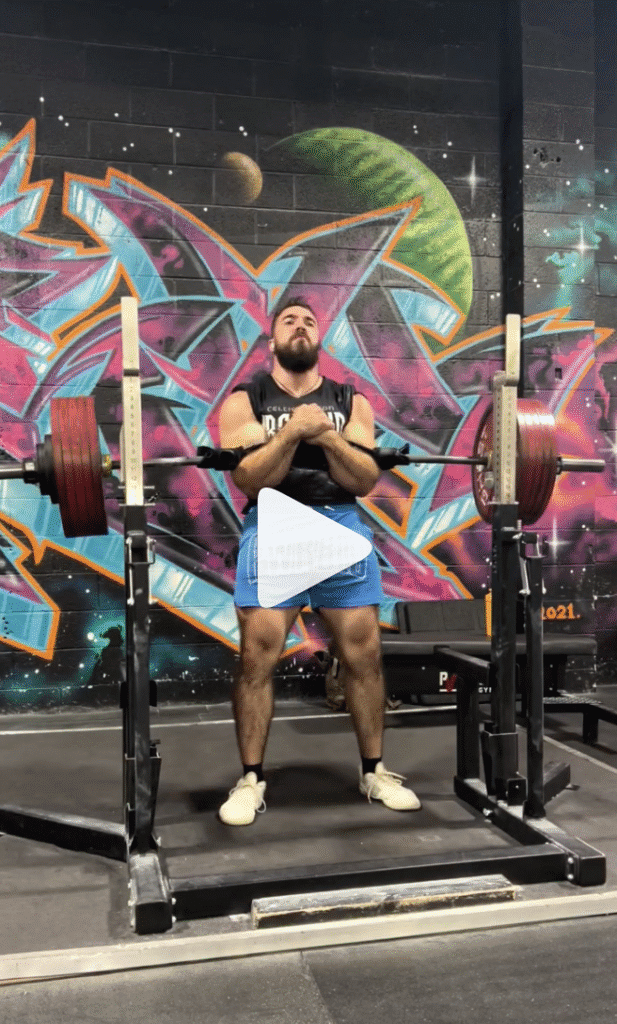New Level Strong: What We Can Learn from Brendan Todd’s Breakthrough
Brendan’s 2104 total in action.
Too many strength coaches hide behind hundred-dollar words while moving fifty-cent barbells.
That kind of circle jerk might impress academics in the ivory tower, but it won’t build cock-strong, son-of-a-bucks in the real world.
Let’s look at something that does work in the real world—and has built one of the strongest men walking the planet: Brendan Todd. With multi-disciplinary success across powerlifting, strongman, street lifting, and strict curl, he’s the best of both worlds—at 25 years old, an old-school throwback with a modern edge!
Some lifters are disciplined with diet, never miss workouts, but they overthink everything. They’ll go into a meet primed for a 50-pound PR and leave with 12 because their own mental equations became a self-fulfilling prophecy.
Other lifters can get stuck sleeping on an airport floor the night before a meet, show up exhausted, and still hit huge PRs. They’re convinced circumstances don’t matter. That daredevil mindset helps them push limits, but they’re usually disorganized, inconsistent, and miss training.
The best, most mentally tough lifters I’ve ever coached—including Brendan—are the ones who take the positives from both sides: disciplined and organized, but adaptable with balls of steel. That mix is rarer than finding an Allsup’s chimichanga still warm at 3 a.m.—and it’s a big part of what makes Brendan so damn special!
I’ve coached Brendan since 2021, and every single year the man levels up. But 2025 has been his year. In a “what have you done for me lately” strength world, Brendan answered loud and clear—winning the Arnold Classic under 120 kg strongman, setting strict curl records, and becoming a street lifting champion.
And as if that wasn’t enough, Brendan dropped the hammer with his powerlifting—a 2104 raw total, a monster leap from his previous best of 1962—all completely drug free. (Would have placed first at Nationals and third at Worlds.)
Let’s break down some of the strategies I had Brendan implement—and that he masterfully executed—to turn hard work into a world-class powerlifting total.
Off-Season: Where Champions Are Made
The off-season isn’t a vacation—it’s where the foundation for record-breaking totals gets poured. A point I hammer to clients, and the successful ones understand: meet prep is about demonstrating strength; the off-season is about building it.
For Brendan Todd, this phase was huge. He wasn’t locked into a cookie-cutter powerlifting cycle—he was chasing street-lifting glory with max-effort chins and dips, hammering strict curl contests, and testing himself in strongman. That cocktail blurred the lines but sharpened the sword.
Off-season length varies—sometimes it’s right after a meet, sometimes 10 weeks out. It can run 4–12 weeks, but to last in this game, I tell lifters to dedicate at least (bare minimum) 16 weeks every year. In prep, singles and doubles keep workload low, numbers rise, but growth stalls. The off-season is different—that’s when muscle and capacity stack up, and heavy stops feeling heavy.
All this while staying 100% drug-free. Brendan’s work capacity is unmatched. He grinds through bodybuilding sets, smashes weighted chins and dips, then runs hill sprints and throws kicks in Muay Thai for dessert.
That off-season wasn’t downtime—it was a launchpad.
Why the Off-Season Matters
- Fix weaknesses: This is the only time you can hammer lagging areas holding you back.
- Experiment: We added new training methods to keep his performance climbing. Remember—everything works, but nothing works forever.
- Volume = capacity: Bodybuilding-style higher volume gave Brendan the ability to handle heavier weights for longer, without frying his CNS.
- Arms and back: Bigger arms stabilize the bar on bench. A thicker trunk (upper back) means less sway under load. Think oak tree in a storm.
- Isolation work: Weak muscles need direct hits. Compound lifts let stronger areas cover the slack, but isolation forces progress where it counts.
- Break without boredom: We shifted training styles, but never slacked—shorter rest, higher volume, and new disciplines like Muay Thai and hill sprints kept the fire lit.
- Movement variation: Specialty bars, dumbbells, and smart swaps for the big three strengthen the lifts themselves while capitalizing on strategic variation.
Streetlifting: Raw Upper-Body Power
A huge piece of Brendan’s off-season was street lifting—weighted dips and chin-ups pushed to gargantuan levels. This isn’t fluff. Brendan was hammering dips with 300 pounds strapped on and cranking out and 200 pound weighted chin-ups most lifters couldn’t manage even with just bodyweight.
Street lifting sharpened the sword:
- Dips → Bench: Built the triceps lockout, chest drive, and shoulder stability that transferred straight to the press.
- Chins → Deadlift & Bench: Packed his lats and grip, giving him a back shelf to pull from and stability to press off.
I’ve seen this play out before. Back in 2005, prepping for Atlantis Strongest Man in America, I ran a dip-and-chin cycle and came out pressing 445 overhead and benching 600 with ease. Charles Poliquin and other old-school coaches were preaching it long before “street lifting” was a hashtag. Turns out they were right—it works.
For Brendan, it wasn’t just accessory work. It was a main driver. The carryover into his powerlifting total was undeniable.
Application Point: CONSIDER Running cycles of weighted dips and chin-ups in your off-season. Progressively overload them just like the big three. They’ll stack meat on your frame, blow up your lockout power, and give you pulling strength that transfers straight to the platform.
Brendan smashing reps at 242 on dips.

Strict Curl
Brendan’s off-season also featured strict curl contests—yeah, you heard that right. But it wasn’t just ego-lifting in front of a curl rack. It was another brick in the wall.
Heavy curls stabilize heavy benches. A thick arm isn’t just for show—it anchors the bar, supports the elbow joint, and adds stability when hundreds of pounds are in your hands. Same way a thick tree trunk sways less in a storm, stronger arms keep you steady when it counts.
Brendan put his arms through the wringer in off-season cycles. That extra biceps and forearm strength carried right over into his bench and overall strength.
Application Point: Don’t laugh off curls. Train your arms heavy and strict (low rep ranges 1-5 reps). Stronger arms stabilize your bench and deadlift, and more arm mass means more total power when the stakes are high.
Brendan with a 215 pound strict curl

Strongman: The Base Builder
Strongman training was worth its weight in gold for Brendan. We weren’t playing around with circus lifts—we stuck to the meat and potatoes that make lifters dangerous:
- Backwards sled drags: Gave Brendan knee armor and quad strength, kept joints healthy, and built a gas tank most powerlifters flat-out don’t have.
- Yoke walks: Put steel in his upper back, dialed in core stability, and made 700+ on his back in the squat feel less like a guillotine and more like business as usual.
- Farmer’s carries: Forged grip strength, packed meat on his traps and forearms, and built total-body tension under load.
Strongman wasn’t just a side dish. It gave Brendan explosive strength, work capacity, and resilience. That kind of training is why he could handle volume, peak heavy, and still stay healthy when the bar got loaded.
Application Point: Strongman isn’t just for strongman. Add sled drags, carries, or yoke work to your off-season. It’ll build your work capacity, grip, and toughness—qualities that transfer directly to powerlifting, to bouncing at Kick n’ Stab, that West-By-God-Virginia dive bar, or to any situation where raw physical strength matters.
Brendan repping 800 on the trap bar and Zercher squatting 630

Getting Jacked: Hypertrophy with Purpose
When we talk about hypertrophy around here, we’re talking about strength potential. Performance. Moving real weight—not shaking it on stage like some Chippendales reject greased up for a wine mom bachelorette party.
Muscle hypertrophy isn’t just for show—it’s the raw material for strength. More muscle means more contractile units ready to lift heavy weight on the platform!
Neurological wiring isn’t enough—you need tissue to recruit. Intelligent hypertrophy gives you leverage, boosts motor unit recruitment, and primes you for explosive performance. That’s why Brendan smashed through off-season bodybuilding work like a machine. More volume. More reps. More muscle. Then he turned that mass into horsepower.
I’ve seen it over and over. Bodybuilders I’ve coached who cross into powerlifting blow past PRs because they’ve already built the muscular base. Once you prime that muscle with neural efficiency? Game over.
Application Point: Don’t skip hypertrophy phases. Build muscle in the off-season. More muscle = more potential for force production. If you want to lift bigger weights, you need to get jacked.
From Off-Season to Meet Prep
The off-season gave Brendan the platform—meet prep gave him the launch. Instead of a hard pivot, we made the handoff smooth. The mental side is just as important as the physical, and it’s often overlooked. In football, the hardest hits usually happen on the first day in pads or alumni games—guys are fresh, fired up, and ready to unload. Same thing in lifting: the off-season sets you up to come in primed, not worn down.
I’ve always said: I may not have the fastest horse in the race, but I can have the freshest. Some lifters twist that into meaning easy training—what I call poodle-dick work. Couldn’t be further from the truth. The way I keep athletes fresh is by keeping the off-season different. Brendan wasn’t stuck grinding the same stale lifts—he was street lifting, curling, and hitting strongman work. That variety let him push hard without burning out.
So when it came time to prep, he didn’t limp in—he came in fresh, confident, and ready to attack. Squats were hammered in fives, climbing into the 700s. That built size, strength, technique, and confidence—the whole package. On bench, we reset with six sets of five, dialing in groove and efficiency after the off-season detour. The strength didn’t creep back—it roared.
And come meet day? I don’t need the fastest horse. I need the freshest. That’s Brendan. All of this is phase potentiation—the foundation laid so the next phase has the greatest potential for success.
Attack the Weights, Live to Lift Another Day
This wasn’t reckless training. Brendan attacked every rep with intent, but he always left something in the tank. He never tried to win training—he trained to win when it mattered.
The principle comes straight out of the Ed Coan playbook: live to fight another day. The best training cycles aren’t about burning out or chasing failure—they’re about stacking quality sessions until the peak. Walking out of the gym knowing you could’ve done one more rep is often the difference between progress and burnout.
I like to say the hardest football hits come at alumni games—the guys are fresh, excited, and overdo it. Same idea here: keep your powder dry. Brendan mastered that balance.
Every day is Back Day.
Kaz said it best: a strong man equals a strong back. Squat, bench, or deadlift—it all comes back to the back. A thick, powerful trunk not only projects strength, it creates stability under the squat bar, a shelf for the bench press, and raw horsepower off the floor on deadlifts. Brendan has leaned on this strategy for years, and the payoff shows across the board.
Application Point:
The upper back can take a beating and recover fast. That’s been critical for keeping his shoulders healthy, his squat stable, and his pulls locked in. Remember, the lower back recovers slowly. When increasing back frequency, lean on pull-up variations, pulldowns, and chest-supported or cable rows. Bent-over rows tax the lower back—they’re not a one-to-one substitute for chest-supported rows.
The Big Picture
In the past, Brendan had a habit of overshooting and pushing past the plan. This time, he trusted the process. He executed the program as written—every set, every rep, no more, no less. The result? He modeled the kind of training discipline that separates the good from the great.
Strong back, strong arms, strong execution—the culmination of off-season building and meet prep discipline. That’s why Brendan is rewriting what’s possible.
Strength Across Every Arena
Brendan isn’t just a powerlifter—he’s already a strongman champion, a street lifting champion, and a strict curl champion. He’s like the old-school powerbuilders: dominant in all strength sports, backed by a physique carved out of raw work ethic and consistency.
This guy doesn’t just train—he embodies the total package. He’s building records, stacking championships, and doing it with the look and presence of a throwback iron legend.
Determination That Can’t Be Taught
I first met Brendan when he was a broke college kid who drove hours to one of my seminars on the east coast. He saved up every penny he had just to be there. That kind of hunger is rare. It’s the same hunger that’s carried him to PR totals and championships—and it’s the same hunger that’s going to carry him even further.
He’s determined. He’s focused. He’s special. I know what it takes, and he’s got it.
Build your strongest self with one of Josh’s programs on TrainHeroic HERE

